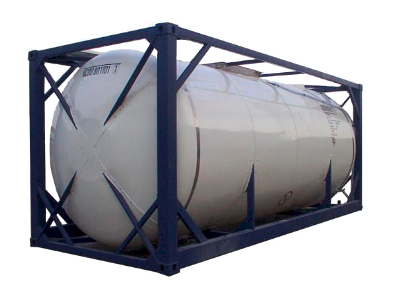 Tank container (20-foot tank container) — multimodal transport unit, intended for the carriage of liquid chemical and food products as well as liquefied gases the three types of transport: sea (river), rail and road.
Tank container (20-foot tank container) — multimodal transport unit, intended for the carriage of liquid chemical and food products as well as liquefied gases the three types of transport: sea (river), rail and road.
Transportation in tank-containers under the technology of «door to door» without intermediate overflow of the product when changing the mode of transport that provides improved transportation safety and the safety of the cargo.
The use of tank containers allows you to optimize logistics operations for the transport of liquid chemicals and food cargo and liquefied gases due to the lower cost of rail fare in comparison with the transport in tank-wagons. An additional advantage is the possibility of rapid handling of tank containers from one mode of transport to another, except for the overload of products for bulk terminals.
The main producers of food and chemical tank containers — CIMC (China), Van Hool (Belgium), Welfy Oddy (South Africa), Uralkhimmash (Russia), etc. In the main tank containers are manufactured in China. World leader CIMC produces almost 60% of planetary production.
Almost all tank containers are made on the basis of 20-foot container frame. Tank containers on the basis of a 30-foot frame almost not produced. 40-foot containers typically for liquefied gases (LPG, LNG).
The basic layout of tank containers:
• Standard 20-ft tank container has a volume of 14 million liters to 26 million liters. Most used — 26, 25, 24 thousand liters. For heavy liquids — 21 thousand liters and less 17.5 thousand.
• Increased the volume have a swap-containers (SWAP) — from 30 to 36 thousand litres. Swap containers are standard 20-ft. frame width and height. Depending on the amount of length — 7.15, 7.45 or 7.82 m.
• Gas tank containers typically have a volume of 24 thousand liters, a pressure of from 15 to 34.5 bar.
For the classification previously used the old system (IMO-1, IMO-0, IMO-2, IMO gas-5). According to Portable Tank Instruction system is used T-codes T1 to T75.
The most common codes:
• T11 — operating pressure 4 bar, bottom unloading (analogous to the old IMO1)
• T14 — operating pressure 4 bar, top unloading
• T4 — working pressure 1.77 bar
• T50 gas tank containers
The basic design of tank containers:
• with thermal insulation or without
• with steam jacket for heating by steam or hot water and / or without
• thermometer, ladder, walkway on top, etc.
• tank of stainless steel 316 or 304, or from structural steel
• tank with internal coating for acids
Certification of tank containers is carried out by classification companies: Bureau Veritas (Bureau Veritas),Lloyd’s Register (Lloyd’s Register), DNV, SGS or similar, and also Russian Maritime register of shipping.
Rules of safe operation are detailed in the «Safe Handling of Tank Containers» International Tank Container Organization ITCO.
